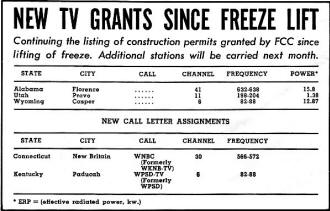Spot Radio News
|
||
Two major radio events were covered in this 1954 issue of Radio & TV News magazine's monthly "Spot Radio News" column - the rapid advance of microwave technology for building out high capacity voice and television transmission systems, and the ever-increasing number of new TV station operation license grants since the ending of the Federal Communications Commission (FCC) moratorium in 1952. In 1944, the FCC stopped issuing broadcast permits due to serious unforeseen interference from co-location interference issues as post-war households enthusiastically adopted TV. Unlike today's microwave relay networks, in the 1950s most systems were still analog in nature. Coaxial cable installations were good, but use over extra long distances and in difficult to access areas limited their applicability. Line-of-sight limitations between relay towers required building more sites than might otherwise be required, but the advantage was significantly narrower beamwidths that allow more channels in a give volume of space, and the characteristic gain of directional antennas permitted lower power at the transmitted and and better reception at the receiver end. Presenting latest information on the Radio Industry
Washington Editor Microwaves, the new work-horse of radio now being sought by an increasing number of radio and TV broadcasters and an unending list of public and private agencies, is now on trial in Washington. The tremendous demand for these upstairs channels (890 to 13,000 mega-cycles) has jammed the Commission's hearing schedule and dictated a fact-finding session that will provide a pattern for, the future use and requirements of the microwave belt. A variety of advantages has been responsible for the rising popularity of the microwave signals. They can be directed to any selected spot within view of the transmitter and, by means of successive repeater stations, relayed over added distances. Microwave communications can be in the form of voice and telegraph correspondence, also teletype, facsimile, and TV-relay services. Further, microwave facilities permit push-button observation of industrial and other business operations, and remote control of device's throughout a system. By methods known as multiplexing, many messages or functions may be handled simultaneously over a single microwave channel.
A major part of the nationwide TV program network operates over microwave systems provided by the telephone companies. In other cases, where such facilities are not available from the telephone companies, individual TV stations have installed their own private microwave relay systems. Also serving TV are the microwave links which carry programs from the local city studios of a broadcaster to the distant transmitter site of the TV broadcast station. Portable and mobile microwave transmitters make it possible to pick up news, sports, and other events outside of the regular studios and deliver them to the transmitter. Microwave adjuncts for TV broadcasting, other than intercity circuits operated by common carriers, operate in bands at 2000, 7000, and 13,000 megacycles.
Posted March 30, 2020 |
||

 By Radio & Television News
By Radio & Television News 